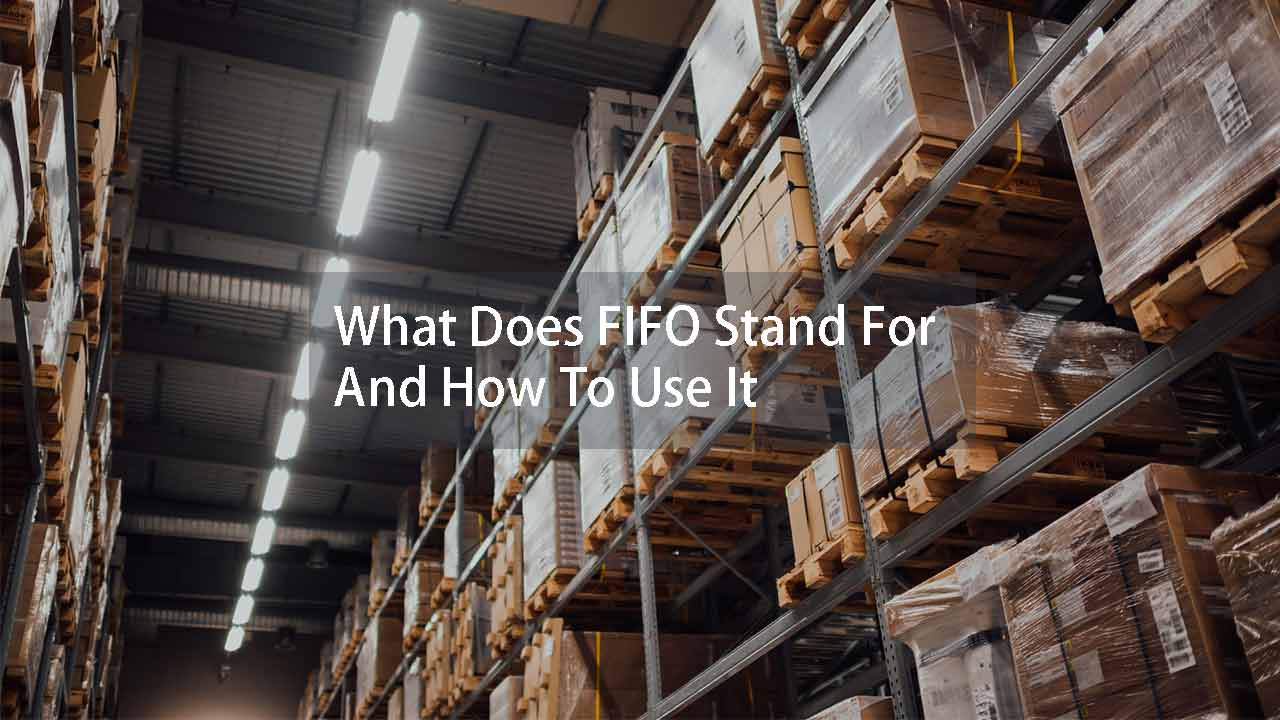FIFO, short for First In, First Out, is a powerful concept that plays a pivotal role in inventory management, logistics, and financial accounting. By mastering this principle, businesses can optimize their operations and maximize profits.
This article will dive into inventory management, revealing how the FIFO method streamlines processes and reduces waste.
As you uncover the true potential of FIFO, you’ll be eager to apply it to your business ventures. Don’t miss out on this game-changing information. Read on to learn more!

What Is First-In, First-Out (FIFO)
It is a straightforward inventory valuation method that assumes items acquired or produced first will be sold first. Ideally, this implies that the oldest inventory gets shipped out to customers before the newer stock.
When determining the value of ending inventory, the cost of goods sold (COGS) of the oldest inventory is used, regardless of any recent cost changes.
Understanding The FIFO Inventory Valuation Method
E-commerce inventory is considered an asset, so it’s essential to calculate COGS at the end of the accounting period or fiscal year. Ending inventory value affects balance sheets and inventory write-offs.
Typically, due to inflation, more recent inventory costs are higher than older inventory. The FIFO method sells lower-value goods first, resulting in a higher ending inventory value. Any remaining stock at the end of the financial year does not impact COGS.
It’s noteworthy that FIFO (First-In, First-Out) is designed for inventory accounting purposes and offers a simple formula to calculate ending inventory value. However, in many cases, the first items received are only sometimes fulfilled first.
For products with short shelf lives, perishability, or quick obsolescence, the FIFO method provides proper inventory management and an easy way to calculate ending inventory value.
By calculating inventory value corresponding to the natural inventory flow throughout the supply chain, businesses can monitor quality and reduce holding costs for obsolete or unsellable inventory (also known as dead stock).
Example Of FIFO
According to the FIFO cost flow assumption, the cost of the beginning inventory is multiplied by the COGS for the amount of inventory sold.
Imagine a bakery that initially buys 100 bags of flour at $2 each. Later, they purchase 200 more bags at $3 each due to a price increase. The bakery now has 300 bags of flour in stock and sells 150 bags.
In their balance sheet, the total COGS for the 150 bags sold would be:
COGS = (Number of Original Units x Its Value) + (Remaining Units From the Second Purchase x Its Value)
COGS = (100 x $2) + (50 x $3) = $350
The cost of the oldest inventory items is used first in the COGS calculations (the initial purchase of 100 bags at $2/each), and the remaining 50 bags use the second purchase cost of $3/each. The value of the remaining or ending inventory (150 bags) is then calculated:
Ending Inventory Value = Remaining Units x Its Value
Ending Inventory Value = 150 x $3 = $450
Too hard to calculate the cost? we can help you.
FIFO Vs. LIFO – What Is The Difference?
LIFO, or Last-In, First-Out, is an alternative inventory valuation method to FIFO, or First-In, First-Out. While FIFO assumes the oldest items are sold first, LIFO prioritizes selling the newest stock.
LIFO is legally used only by US-based businesses, whereas FIFO is more widely accepted under International Financial Reporting Standards (IFRS).
Key Features of LIFO
- LIFO focuses on selling the most recently acquired products first.
- It may lead to lower reported profits due to higher COGS, especially during inflationary periods.
- LIFO can result in tax savings when product costs are rising, though the IRS prefers FIFO as it results in higher income tax.
- Businesses must file Form 970 with the IRS to use LIFO.
Comparison of FIFO and LIFO
They have distinct differences in their approach to inventory valuation:
- Inventory Flow: While FIFO emphasizes selling the oldest stock first, LIFO prioritizes selling the newest stock.
- Profitability: FIFO generally reports higher profits using lower-cost inventory in COGS calculations. Conversely, LIFO may show lower profits due to using higher-cost, newer inventory for COGS.
- Tax Implications: LIFO can provide tax advantages during rising prices, while FIFO offers no such benefits.
- Transparency And Accuracy: FIFO is considered more transparent and accurate compared to LIFO.
- Industry Practices: Some industries, like auto dealerships, might benefit more from LIFO, while others prefer FIFO.
Factors To Consider When Choosing Between FIFO And LIFO
When deciding between them, businesses should weigh several factors:
- Product Shelf Life: For perishable goods or items with short shelf lives, FIFO is a more suitable method to ensure optimal product quality.
- Inflation: LIFO might be favorable during inflationary periods, as it can lead to tax savings by reporting lower profits.
- Industry Practices: Companies should consider industry norms and practices when selecting an inventory valuation method, as some industries may prefer one method over the other.
- Financial Reporting: The choice between FIFO and LIFO can impact financial statements, affecting profitability and balance sheet values. Businesses should consider the implications of each method on their financial position and reporting requirements.
Pros And Cons Of FIFO
While the FIFO method is commonly used in inventory management, it has advantages and disadvantages. Understanding these pros and cons will help businesses make informed decisions when choosing an inventory valuation method.
Pros
- Better Product Quality: FIFO ensures that older items are sold first, reducing spoilage and ensuring customers receive fresh products.
- Lower Waste: Selling older products first minimizes waste due to spoilage or obsolescence.
- Simpler Record-Keeping: FIFO simplifies tracking inventory, as items are sold in the order they were received.
- Higher Reported Profits: FIFO leads to higher earnings during rising costs, as COGS calculations use lower-cost inventory.
- Better Inventory Control: FIFO allows for more effective management of stock levels, leading to better organization and efficiency.
- Cost Reduction: Implementing FIFO can help reduce overall operational costs by minimizing waste and maintaining optimal inventory levels.
- Improved Customer Satisfaction: Providing fresher products can increase satisfaction and repeat business.
- Accurate Profit Margin Representation: FIFO offers a reliable way to calculate profit margins, ensuring businesses remain financially sound.
- Lower Business Losses: By prioritizing the sale of older inventory, businesses can minimize potential losses related to spoilage or outdated products.
Cons
- Discrepancies In COGS: The FIFO methodcan result in significant discrepancies when COGS increase dramatically, as it uses older, lower-cost inventory for calculations.
- Impact On Profits: Using outdated values in COGS calculations can negatively affect profits if product costs rise substantially.
- Limited Tax Advantages: FIFO does not provide tax benefits except during falling prices, unlike LIFO, which can offer tax savings during inflationary periods.
Which Inventory Method Should You Use?
It’s essential to consult with an accountant before making this decision. However, the FIFO method is often recommended for various reasons.
For companies selling products that require fulfilling older inventory first due to quality concerns, such as perishables or time-sensitive goods, the FIFO method aligns with the natural stock flow and provides accurate numbers.
Retailers dealing with food items, cosmetics, or electronics can benefit from FIFO, as it helps avoid inventory write-offs or write-downs when demand is slower than expected.
FIFO (First-In, First-Out) also ensures that businesses are more likely to use the actual price paid for goods in their income statements, resulting in more accurate and straightforward calculations and easier record-keeping.
Moreover, choosing FIFO can help avoid scrutiny from tax authorities like the IRS, as it is widely accepted and considered more transparent.
It is typically the preferred option for businesses outside the United States due to its compliance with International Financial Reporting Standards (IFRS).
The Bottom Line
If you’re looking to streamline your inventory management processes and increase your bottom line, we strongly recommend NextSmartShip’s inventory management system.
Get Custom Solutions
Our FIFO (First-In, First-Out) solution is both cost-effective and efficient, providing you with all the tools you need to manage your inventory with ease and boost your profits.
Don’t put off optimizing your inventory management any longer. Get in touch with us today for more information and a demo of our system.


